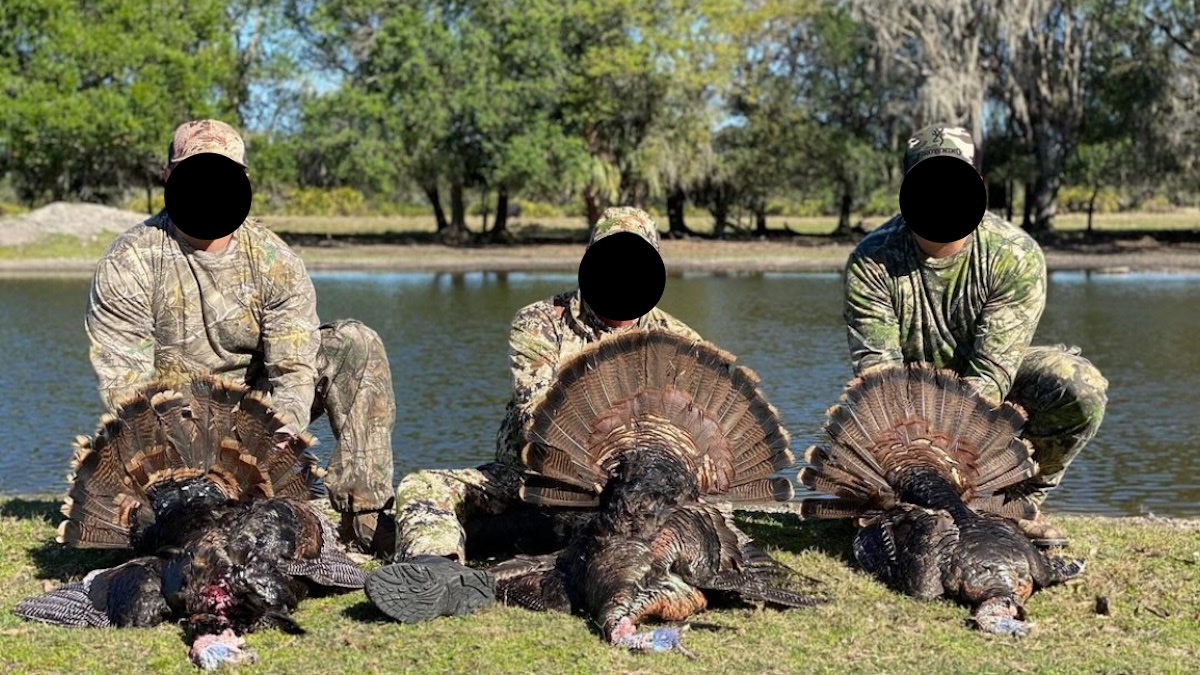Florida Men Arrested for Scheme to Sell Fake Osceola Turkey Hunts

Four Florida men have been arrested and charged for defrauding hunters looking to kill Osceola turkeys.
Larry William Collins, David Preston Mills, Paul Neil Beckham and Vernon Robert Flowers were charged with multiple felonies, including organized fraud, conspiracy to commit organized fraud, cheating and the unlawful use of a two-way communication device, according to the Florida Fish and Wildlife Conservation Commission.
“Collins knowingly and intentionally represented his captive-raised turkeys as Osceola turkeys for unsuspecting hunters to pay large sums of money to hunt the Florida Osceola wild turkey,” said Lt. Col. Randy Bowlin, FWC Deputy Director of Law Enforcement over North Operations and Investigations/Intelligence.
Investigators say these four fellas raised birds to look like wild Osceola turkeys and then tricked unsuspecting clients into thinking they were hunting the real deal. They defrauded 10 clients out of a total of $25,362 from March 2020 through March 2022, including one client who paid for a hunt with “$2,000 in bartered dental work,” according to an affidavit obtained by MeatEater.
Collins operated the Razzor Ranch Blanket Hunting Preserve in Hardee County, and Mills managed a game farm in Charlotte County. Mills bred the fake Osceola turkeys, and Mills and Beckham acted as guides.
Because no story like this would be complete without a shady taxidermist, Flowers mounted the fraudulent turkeys as the owner of Skins and Scales Taxidermy. Collins completed the laundry cycle by receiving a 10% kickback from Flowers for referring the taxidermy business.
Their troubles began when one of their clients took his bird to a different taxidermist. That taxidermist noticed that the color of the bird was not what he normally observed for an Osceola. The bird was also abnormally large and with short legs like a domestic turkey, and the feet were large and deformed like a domestic breed. When he cut the bird open, he noticed that the bird was much fattier than a normal wild turkey.

The client complained to the FWC, and the agency launched an investigation. Law enforcement officers sent the bird to a DNA lab, which determined that the bird was a genetic mix between a domestic turkey and a bronze turkey (another type of domestic turkey).
Razzor Ranch Blanket Hunting Preserve has scrubbed any mention of Osceola turkeys from its website, but a little Internet sleuthing on the Wayback Machine reveals that, sure enough, the website used to advertise Osceola turkey hunts. They had a section on the “Turkey Grand Slam Quest in Florida” and called Osceola’s “the most coveted and sought after game bird species in Florida and around the world.”
For non-turkey hunters, this might sound like much ado about nothing. Passing off pen-raised birds as wild birds is obviously sketchy (and illegal in Florida in some instances), but who cares what subspecies of turkey they were?
One of the ultimate goals of most hard-core North American turkey hunters is to complete a Grand Slam. This is when a hunter harvests all four subspecies of turkeys that live in the U.S. These are the Eastern, the Rio Grande, the Merriam’s, and the Osceola, also called the Florida wild turkey.
Osceola turkeys only live in Florida, and so they’re one of the toughest subspecies to get. You can see how hunters chasing a Grand Slam would be willing to lay down some cash for a chance to get one of these Florida birds, and maybe overlook some discrepancies with the way the “hunt” went down or what the birds looked like.
You can also see how upset they’d be to learn that an outfitter played on their desire to achieve a Grand Slam and that their work hunting the birds was for naught. Talk about adding insult to injury.

Osceola turkeys look like Easterns, but they’re smaller and darker in color and have wider black bars on the wing feathers. However, those distinctions can be difficult to notice, and that’s especially true if these birds were raised to look like Osceolas and the clients are unfamiliar with an Osceola’s morphology.
Razzor Ranch claims on its website that as a licensed hunting preserve, it is legal for them to release captive-reared game birds to restock the area for the season. However, according to an affidavit obtained by MeatEater, Collins was told by an FWC representative that, “A captive reared turkey, whether native to the State or not, with domestic turkey lineage is not considered a game bird.”
“This fraudulent scheme not only deceived hunters but also exploited a revered species of Florida’s wildlife,” said Bowlin. “We want public, private, and tribal landowners to know that we are working diligently to ensure that captive raised, nonwild turkeys will not be released near their lands. Hunters can be reassured that the opportunity to hunt a wild Osceola turkey will remain, and legitimate outfitters will not have competition from unethical and fraudulent turkey guide services or outfitters.”
The charges filed against the defendants are as follows:
- Larry William Collins (DOB: 12/8/1965) of Punta Gorda: Organized Fraud, Conspiracy to Commit Organized Fraud, Cheating, Unlawful use of a Two-Way Communication Device.
- David Preston Mills (DOB 7/9/1967) of Arcadia: Organized Fraud, Conspiracy to Commit Organized Fraud.
- Paul Neil Beckham (DOB 6/3/1975) of Punta Gorda: Organized Fraud, Conspiracy to Commit Organized Fraud, Cheating, Unlawful use of a Two-Way Communication Device.
- Vernon Robert Flowers (DOB 07/28/1952) of Naples: Organized Fraud, Conspiracy to Commit Organized Fraud.
A representative from the FWC Division of Law Enforcement said that this isn’t the only outfit running this kind of confidence scheme. Those other violators are being identified, investigated, and arrested as warranted.
FWC determined two out of three turkeys in the feature image were not Osceolas. Images via affidavit obtained by MeatEater.




